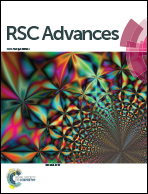Microwave synthesis of high luminescent aqueous CdSe/CdS/ZnS quantum dots for crystalline silicon solar cells with enhanced photovoltaic performance
Abstract
Water-dispersed CdSe/CdS/ZnS core/shell/shell quantum dots (QDs) with the highest quantum yield of 25.4% were first synthesized for each component by microwave irradiation. As-prepared QDs do not only possess a large Stokes shift but also exhibit excellent repeatability. They can convert near UV and blue light with lower sensitivity to the Si solar cell to red light at which the solar cell has higher sensitivity. The fabricated CdSe/CdS/ZnS QDs/SiO2 composite films were applied to Si solar cells as luminescent down-shifting layers and the effect of QDs on the photoelectric conversion efficiency of photovoltaic modules was investigated. Under one sun illumination, the composite film containing an appropriate amount of CdSe/CdS/ZnS QDs effectively enhances the photoelectric conversion efficiency of the Si solar cell by spectral down-shifting as compared to the bare glass substrate, and the maximum achieves 16.14%.


 Please wait while we load your content...
Please wait while we load your content...